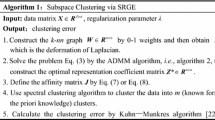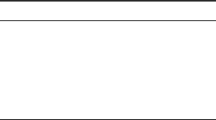Abstract
Subspace clustering aims to group high-dimensional data samples into several subspaces which they were generated. Among the existing subspace clustering methods, spectral clustering-based algorithms have attracted considerable attentions because of their predominant performances shown in many subspace clustering applications. In this paper, we proposed to apply smooth representation clustering (SMR) to the reconstruction coefficient vectors which were obtained by sparse subspace clustering (SSC). Because the reconstruction coefficient vectors could be regarded as a kind of good representations of original data samples, the proposed method could be considered as a SMR performed in a latent subspace found by SSC and hoped to achieve better performances. For solving the proposed latent smooth representation algorithm (LSMR), we presented an optimization method and also discussed the relationships between LSMR with some related algorithms. Finally, experiments conducted on several famous databases demonstrate that the proposed algorithm dominates the related algorithms.









Similar content being viewed by others
Explore related subjects
Discover the latest articles, news and stories from top researchers in related subjects.Notes
Namely, if \({\Vert{\mathbf{x}}_{i} - {\mathbf{x}}_{j}\Vert}_{2}^{2}\to 0\), we have \({\Vert{\mathbf{c}}_{i} - {\mathbf{c}}_{j}\Vert}_{2}^{2}\to 0.\)
In our experiments, \(\varepsilon =0.01.\)
It also contains a sequence of 5 motions which is called “dancing”. We neglect this sub-database in our experiments.
The choices of PCA dimension is followed the suggestion in [5].
Segmentation error = 1 − segmentation accuracy.
References
Parsons L, Haque E, Liu H (2004) Subspace clustering for high dimensional data: a review. SIGKDD Explor Newsl ACM Spec Interes Gr Knowl Discov Data Min 6:90
Vidal R (2011) Subspace clustering. IEEE Signal Process Mag 28:52–68. https://doi.org/10.1109/MSP.2010.939739
Elhamifar E, Vidal R (2009) Sparse subspace clustering. In: 2009 IEEE Computer Society Conference on Computer Vision and Pattern Recognition Workshop CVPR Workshops 2009, IEEE, pp 2790–2797. https://doi.org/10.1109/CVPRW.2009.5206547
Elhamifar E, Vidal R (2013) Sparse subspace clustering: algorithm, theory, and applications. IEEE Trans Pattern Anal Mach Intell 35:2765–2781. https://doi.org/10.1109/TPAMI.2013.57
Liu G, Lin Z, Yu Y (2010) Robust subspace segmentation by low-rank representation. In: ICML 2010—proceedings, 27th international conference on machine learning
Liu G, Lin Z, Yan S et al (2013) Robust recovery of subspace structures by low-rank representation. IEEE Trans Pattern Anal Mach Intell. https://doi.org/10.1109/TPAMI.2012.88
Rao S, Tron R, Vidal R, Ma Y (2010) Motion segmentation in the presence of outlying, incomplete, or corrupted trajectories. IEEE Trans Pattern Anal Mach Intell. https://doi.org/10.1109/TPAMI.2009.191
Ma Y, Derksen H, Hong W, Wright J (2007) Segmentation of multivariate mixed data via lossy data coding and compression. IEEE Trans Pattern Anal Mach Intell. https://doi.org/10.1109/TPAMI.2007.1085
Vidal R, Favaro P (2014) Low rank subspace clustering (LRSC). Pattern Recognit Lett. https://doi.org/10.1016/j.patrec.2013.08.006
Wei L, Wu A, Yin J (2015) Latent space robust subspace segmentation based on low-rank and locality constraints. Expert Syst Appl 42:6598–6608. https://doi.org/10.1016/j.eswa.2015.04.041
Shi J, Malik J (2000) Normalized cuts and image segmentation. IEEE Trans Pattern Anal Mach Intell. https://doi.org/10.1109/34.868688
Liu R, Lin Z, De La Torre F, Su Z (2012) Fixed-rank representation for unsupervised visual learning. In: Proceedings of the IEEE computer society conference on computer vision and pattern recognition
Liu G, Yan S (2011) Latent low-rank representation for subspace segmentation and feature extraction. In: Proceedings of the IEEE international conference on computer vision
Li CG, Vidal R (2015) Structured sparse subspace clustering: a unified optimization framework. In: Proceedings of the IEEE computer society conference on computer vision and pattern recognition
Li CG, You C, Vidal R (2017) Structured sparse subspace clustering: a joint affinity learning and subspace clustering framework. IEEE Trans Image Process 26:2988–3001. https://doi.org/10.1109/TIP.2017.2691557
Chen H, Wang W, Feng X (2018) Structured sparse subspace clustering with within-cluster grouping. Pattern Recognit. https://doi.org/10.1016/j.patcog.2018.05.020
Zhuang L, Gao H, Lin Z et al (2012) Non-negative low rank and sparse graph for semi-supervised learning. In: Proceedings of the IEEE computer society conference on computer vision and pattern recognition
Tang K, Liu R, Su Z, Zhang J (2014) Structure-constrained low-rank representation. IEEE Trans Neural Netw Learn Syst. https://doi.org/10.1109/TNNLS.2014.2306063
Wei L, Wang X, Yin J, Wu A (2016) Spectral clustering steered low-rank representation for subspace segmentation. J Vis Commun Image Represent 38:386–395. https://doi.org/10.1016/j.jvcir.2016.03.017
Lu X, Wang Y, Yuan Y (2013) Graph-regularized low-rank representation for destriping of hyperspectral images. IEEE Trans Geosci Remote Sens 51:4009–4018. https://doi.org/10.1109/TGRS.2012.2226730
Yin M, Gao J, Lin Z (2016) Laplacian regularized low-rank representation and its applications. IEEE Trans Pattern Anal Mach Intell 38:504–517. https://doi.org/10.1109/TPAMI.2015.2462360
Lu CY, Min H, Zhao ZQ, et al (2012) Robust and efficient subspace segmentation via least squares regression. Lecture notes in computer science (including subseries lecture notes in artificial intelligence lecture notes in bioinformatics). LNCS, vol 7578, pp 347–360. https://doi.org/10.1007/978-3-642-33786-4_26
Hu H, Lin Z, Feng J, Zhou J (2014) Smooth representation clustering. Proc IEEE Comput Soc Conf Comput Vis Pattern Recognit. https://doi.org/10.1109/CVPR.2014.484
Yu J, Tao D, Wang M, Rui Y (2015) Learning to rank using user clicks and visual features for image retrieval. IEEE Trans Cybern. https://doi.org/10.1109/TCYB.2014.2336697
Hong C, Yu J, Tao D, Wang M (2015) Image-based three-dimensional human pose recovery by multiview locality-sensitive sparse retrieval. IEEE Trans Ind Electron 62:3742–3751. https://doi.org/10.1109/TIE.2014.2378735
Hong C, Yu J, Zhang J et al (2019) Multimodal face-pose estimation with multitask manifold deep learning. IEEE Trans Ind Inform. https://doi.org/10.1109/TII.2018.2884211
Zhang J, Yu J, Tao D (2018) Local deep-feature alignment for unsupervised dimension reduction. IEEE Trans Image Process. https://doi.org/10.1109/TIP.2018.2804218
Yu J, Tan M, Zhang H et al (2019) Hierarchical deep click feature prediction for fine-grained image recognition. IEEE Trans Pattern Anal Mach Intell. https://doi.org/10.1109/tpami.2019.2932058
Yu J, Zhu C, Zhang J et al (2020) Spatial pyramid-enhanced NetVLAD with weighted triplet loss for place recognition. IEEE Trans Neural Netw Learn Syst. https://doi.org/10.1109/TNNLS.2019.2908982
Yu J, Yao J, Zhang J et al (2020) SPRNet: single-pixel reconstruction for one-stage instance segmentation. IEEE Trans Cybern. https://doi.org/10.1109/tcyb.2020.2969046
Lin Z, Chen M, Ma Y (2010) The augmented Lagrange multiplier method for exact recovery of corrupted low-rank matrices. https://doi.org/10.1016/j.jsb.2012.10.010
Wright J, Yang AY, Ganesh A et al (2009) Robust face recognition via sparse representation. IEEE Trans Pattern Anal Mach Intell. https://doi.org/10.1109/TPAMI.2008.79
Duda RO, Hart PE, Stork DG (2001) Pattern classification. Wiley, New York
Bartels RH, Stewart GW (1972) Solution of the matrix equation AX + XB = C [F4]. Commun ACM. https://doi.org/10.1145/361573.361582
Wei L, Wang X, Wu A et al (2018) Robust subspace segmentation by self-representation constrained low-rank representation. Neural Process Lett 48:1671–1691. https://doi.org/10.1007/s11063-018-9783-y
Tron R, Vidal R (2007) A benchmark for the comparison of 3-D motion segmentation algorithms. In: Proceedings of the IEEE computer society conference on computer vision and pattern recognition
Samaria FS, Harter AC (1994) Parameterisation of a stochastic model for human face identification. In: IEEE workshop on applications of computer vision—proceedings
Lee KC, Ho J, Kriegman DJ (2005) Acquiring linear subspaces for face recognition under variable lighting. IEEE Trans Pattern Anal Mach Intell. https://doi.org/10.1109/TPAMI.2005.92
Nene S, Nayar S, Murase H (1996) Columbia object image library (COIL-20). Tech Rep
Author information
Authors and Affiliations
Corresponding author
Ethics declarations
Conflict of interest
The authors declared that we have no financial and personal relationships with other people or organizations that can inappropriately influence our work, there is no professional or other personal interest of any nature or kind in any product, service and/or company that could be construed as influencing the position presented in, or the review of, the manuscript entitled.
Additional information
Publisher's Note
Springer Nature remains neutral with regard to jurisdictional claims in published maps and institutional affiliations.
Rights and permissions
About this article
Cite this article
Xiao, X., Wei, L. Robust Subspace Clustering via Latent Smooth Representation Clustering. Neural Process Lett 52, 1317–1337 (2020). https://doi.org/10.1007/s11063-020-10306-8
Published:
Issue Date:
DOI: https://doi.org/10.1007/s11063-020-10306-8




